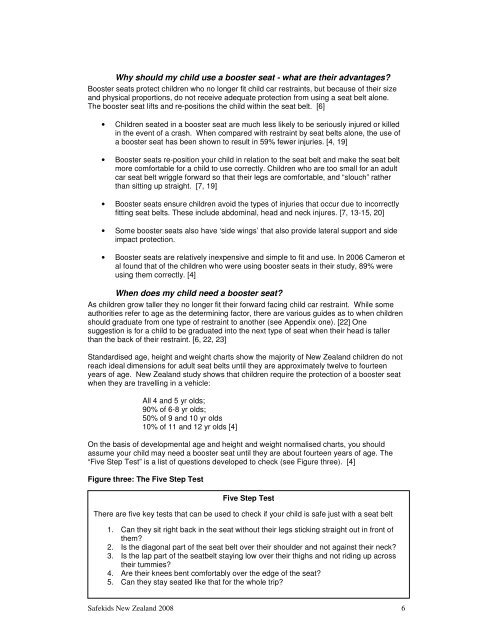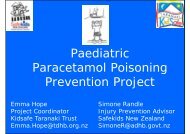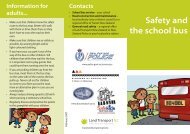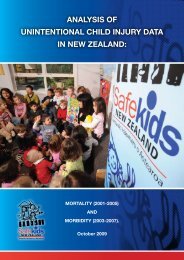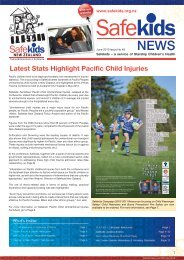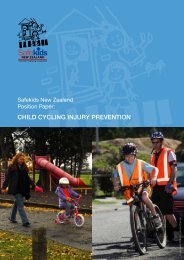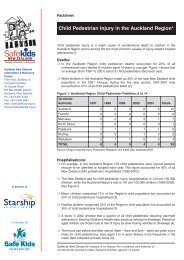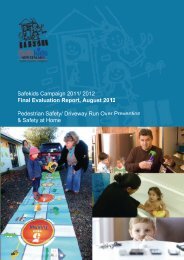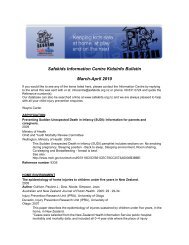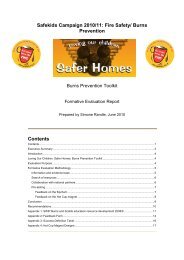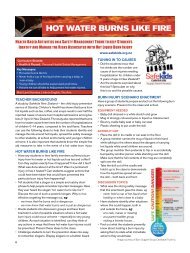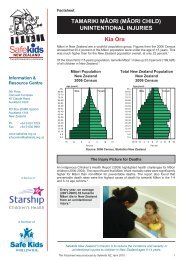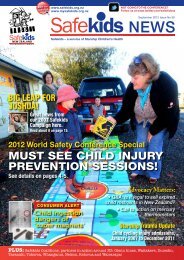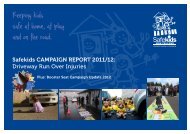Summary It's booster seat time for Kiwi kids - Safekids
Summary It's booster seat time for Kiwi kids - Safekids
Summary It's booster seat time for Kiwi kids - Safekids
You also want an ePaper? Increase the reach of your titles
YUMPU automatically turns print PDFs into web optimized ePapers that Google loves.
Why should my child use a <strong>booster</strong> <strong>seat</strong> - what are their advantages?<br />
Booster <strong>seat</strong>s protect children who no longer fit child car restraints, but because of their size<br />
and physical proportions, do not receive adequate protection from using a <strong>seat</strong> belt alone.<br />
The <strong>booster</strong> <strong>seat</strong> lifts and re-positions the child within the <strong>seat</strong> belt. [6]<br />
• Children <strong>seat</strong>ed in a <strong>booster</strong> <strong>seat</strong> are much less likely to be seriously injured or killed<br />
in the event of a crash. When compared with restraint by <strong>seat</strong> belts alone, the use of<br />
a <strong>booster</strong> <strong>seat</strong> has been shown to result in 59% fewer injuries. [4, 19]<br />
• Booster <strong>seat</strong>s re-position your child in relation to the <strong>seat</strong> belt and make the <strong>seat</strong> belt<br />
more com<strong>for</strong>table <strong>for</strong> a child to use correctly. Children who are too small <strong>for</strong> an adult<br />
car <strong>seat</strong> belt wriggle <strong>for</strong>ward so that their legs are com<strong>for</strong>table, and “slouch” rather<br />
than sitting up straight. [7, 19]<br />
• Booster <strong>seat</strong>s ensure children avoid the types of injuries that occur due to incorrectly<br />
fitting <strong>seat</strong> belts. These include abdominal, head and neck injures. [7, 13-15, 20]<br />
• Some <strong>booster</strong> <strong>seat</strong>s also have ‘side wings’ that also provide lateral support and side<br />
impact protection.<br />
• Booster <strong>seat</strong>s are relatively inexpensive and simple to fit and use. In 2006 Cameron et<br />
al found that of the children who were using <strong>booster</strong> <strong>seat</strong>s in their study, 89% were<br />
using them correctly. [4]<br />
When does my child need a <strong>booster</strong> <strong>seat</strong>?<br />
As children grow taller they no longer fit their <strong>for</strong>ward facing child car restraint. While some<br />
authorities refer to age as the determining factor, there are various guides as to when children<br />
should graduate from one type of restraint to another (see Appendix one). [22] One<br />
suggestion is <strong>for</strong> a child to be graduated into the next type of <strong>seat</strong> when their head is taller<br />
than the back of their restraint. [6, 22, 23]<br />
Standardised age, height and weight charts show the majority of New Zealand children do not<br />
reach ideal dimensions <strong>for</strong> adult <strong>seat</strong> belts until they are approximately twelve to fourteen<br />
years of age. New Zealand study shows that children require the protection of a <strong>booster</strong> <strong>seat</strong><br />
when they are travelling in a vehicle:<br />
All 4 and 5 yr olds;<br />
90% of 6-8 yr olds;<br />
50% of 9 and 10 yr olds<br />
10% of 11 and 12 yr olds [4]<br />
On the basis of developmental age and height and weight normalised charts, you should<br />
assume your child may need a <strong>booster</strong> <strong>seat</strong> until they are about fourteen years of age. The<br />
“Five Step Test” is a list of questions developed to check (see Figure three). [4]<br />
Figure three: The Five Step Test<br />
Five Step Test<br />
There are five key tests that can be used to check if your child is safe just with a <strong>seat</strong> belt<br />
1. Can they sit right back in the <strong>seat</strong> without their legs sticking straight out in front of<br />
them?<br />
2. Is the diagonal part of the <strong>seat</strong> belt over their shoulder and not against their neck?<br />
3. Is the lap part of the <strong>seat</strong>belt staying low over their thighs and not riding up across<br />
their tummies?<br />
4. Are their knees bent com<strong>for</strong>tably over the edge of the <strong>seat</strong>?<br />
5. Can they stay <strong>seat</strong>ed like that <strong>for</strong> the whole trip?<br />
Safe<strong>kids</strong> New Zealand 2008 6


